
Signatures
Signatures
QR Link
Preparation
Transcript
Shane Doyle: Yeah well, that’s perhaps something that you would develop like if you did- if you did find yourself in America for an extended period of timeListen to how 'of' is pronounced as a quick 'OH'(0:10) (Mm-hmm) perhaps you would develop your own signature. (Mm-hmm) You know but as it standsAn idiom meaning 'as something is now, without changes to it'(0:14) like, you know very often you know Japanese kids don’t have a- a need to actually sign their names like a lot so therefore they don’t really develop it you knowThe liaison between the T and the Y is pronounced as “CH-“ as in 'develop ICHUNO'(0:24).
José: They don’t. Uh, but that’s the unfortunate thing because they don’t have need, you could use the old argument about well, they don’t really have a need for English. So when you’re stuck in a moment when you need English, you’re screwed because you never thought that you had a motivation or a need for it so now you can’t speak the language. Same way here, you don’t really have a need for a signature but when you have to sign some important document or a- a (I) you know, a credit card statement-
Shane: Uh well, just let me throw out throw outAn Irish accent tends to pronounce the 'TH” as “T'. Another example is Shane Doyle's pronunciation of 'with'(0:52) an experience that I had (Sure) about signatures, right. Now, I bank I bank withAn Irish accent tends to pronounce the 'TH” as “T'. Another example is Shane Doyle's pronunciation of 'throw'(0:57) my bank for quite a number of years, right? (Mm-hmm) OK when I opened my bank account I just used my signature. (Mm-hmm) Alright, I said, “I have an inkan but preferably I will always use my own signature”, rather than go and get an inkan.
José: So you’re talking about a Japanese bank (Yes, that’s right) and an (and they) inkan is a Japanese seal, right?
Shane: That’s right, eh? So they accepted my signature on the bank book and so on and so therefore whenever I needed anything at the-at the counter I could just sign for it. (Great) Yeah? Now this created a problem for me like, that when you sign your signature, alright very often it’s not the exact same as it was when you first opened your bank account. (Right) So what did that mean for me? That meant that the person who was at the counter would spend ten minutes flipping back and forward back and forward to determine whether or not that signature was exactly the same. (Mm-hhm mm-hmm) Alright? Now, I would- I would say that on about five different occasions I’ve been told that this is not the same signature. (Right) And I’d say, “Well- well I am this person”. (Ha ha) And we would have this back and forth whereby you know, I’m saying “It is my signature,” (Mm-hmm) and they’re saying, “well actually it’s different”. OK? (Yeah) And then and then eventually I’m always asked, “Can you do it again?” (Mm-hmm) and they show me the signature (Mm-hmm) that I had provided at first, and they say, “you’ve got to write it like this,” so I copied that signature (you traced it) which is my own signature so it defeats the purpose (It’s exactly-) of actually of actually you know, me submitting my signature in the first- in the first place.
José: Right, you wanted to make it easy (That’s right) and it ended up hell.
Shane: Easy for me, in the end in the end it has been it has been difficult at times. (Right) You know and we’ve had the argument- I’ve had the argument with, “Are you- are you an expert (Mm-hmm) in reading signatures? Can you tell that that is- that I am not who I say I am?” You know, and we’ve had that I’ve had that argument with some some of the bank staff. (Sure) You know, of course it gets me nowhere because i end up having to copy my own signature (That’s right. Yeah yeah) anyway (I) The point is you feel, “Right, I have to say this.”
José: I I- I think that’s that’s a good point. Tha- but that’s- in a way, that kind of reinforces my idea about it. You’re in Japan.You really should have used an inkan. And in the same way a Japanese person living in America can’t say, “Well this is my personal seal. I want to use this in lieu of a signature.” That won’t work.
Shane: Yeah but you see the point is the bank said you can sign for it or you can use an inkan.
José: Ok well that’s true. They did offer the choice.
Shane: But once you’re given- once you’re given the choice I’l always take the signature. You know because-
José: Not anymore you won’t!
Shane: Well no, I still do. Like to be honest I- you you. (You do? OK OK) I still persevere with it. But I-
José: Haven’t learned your lesson yet, have you?
Shane: Well you know, I think who’s going to learn their lesson? Is it me or the person at the bank, you know? (No, you’re right) Really, like, you know if they’re going to say, if they’re going to accept the signature, they have to be able to deal with it in- in what I think is a sensible fashion. (No, you’re quite right) If they say- if they say you need an inkan, then I will come up with the inkan. (Mm-hmm) I mean that’s just the way it is.
José: They shouldn’t offer the choice (That’s right) if they don’t know how (That’s right) to handle it properly. And uh, and tha- I I think your point is also well made too.
Consolidation
QR Link
Access this article on your mobile device

Signatures
Speakers

José Domingo Cruz
Canadian
Vancouver, British Columbia

Shane Doyle
Irish
Dublin, Ireland
Statistics
- words (including pause words)
- minutes in the mp3 audio
- words per minute for this article
Continue practicing your English fluency with the related posts above, or navigate to other authentic conversations using the Previous and Next buttons below.
Spritz
To spritz only part of this conversation, highlight the text you want and click the “SPRITZ NOW!” button. Clicking the button without any text highlighted will spritz the entire page.
To quickly adjust the words per minute (wpm), you can use the left and right arrow keys.
Writing comments will help your English writing skills. Feel free to ask questions and share opinions. We try to respond to all comments we get on the site. test




Now in 2020, a lot of Japanese people use an inkan. I also used my inkan when I opened my bank account and applied for the scholarship. An inkan has an important part in Japanese society. However, the situation is changing. COVID-19 is going around the world. Many people are forced to stay home and work remotely. The inkan culture is reconsidered because people have to go to their office to put their seal on documents.
In my opinion, still using an inkan can be an option. Because the same things in the text will happen. I mean, one used his or her signature some years ago, and he or she may not be identified as a person who signed at that time because of the change of handwriting. When I review my notebooks in my high school days, I think my handwriting has changed. If we use an inkan, the inkan will not change and it doesn’t take extra time. So I agree with using an inkan.
However, maybe Japan will promote not using an inkan. All we have to do is practice to write our own signature. We have to write almost the same signature compared with past one. This may be a new culture in Japan.